
National
Skydiving
League
226 Pecan Street
Deland FL 32724
tel: (386) 801-0804
© 2003 - 2024
All Rights Reserved


226 Pecan Street
Deland FL 32724
tel: (386) 801-0804
© 2003 - 2024
All Rights Reserved

Each of the three AAA Class top contenders, the Golden Knights, Airspeed Odyssey and Velocity, use the same technique for the new block. The rear piece flies the Side Body, the front piece flies the Compressed Accordian, both pieces rotate forward and slightly sheer the pieces, the front piece gets the memory.

Most of the U.S. top teams and many other teams in the world had the rear piece take the lower part of the vertical techniques in the past. Only the French national team from Maubeuge and its following did it the other way, with the front piece going over in most of the cases.

The best example for the fact that teams now try to find the best technique only for the own team and for each block maneuver is Arizona Airspeed. Both line-ups train side by side in 4-way, join forces and techniques in 8-way and surely communicate any technical topics between the two 4-way teams. They still use different techniques, as Block 12 demonstrates.

Block 21 (Zig Zag - Marquis) is a good example for a block maneuver where several different techniques have been used ever since the current dive pool was created. There was no experience with any other technical option than rotation in the very beginning. However, the sheering technique for Block 21 had its popularity peak in the late 80's and early 90's when teams tried to avoid rotation as much as possible. The current technique for the popular block has the rotation clearly dominating over the sheering.

However, the sheering technique is still a significant part for the new Block 12 and very similar to the technique of the old Block 12 (Zipper - Star). The rear piece takes responsibility for reducing the amount of the turn for the front piece. It sheers forward while getting its required 360 degree turn done.
The rear piece of Zipper - Star used to do the same job, while the front piece was sheering as much as it could, as well. Both pieces had the same configuration. Bundy - Bundy has two different pieces, and the Compressed Accordian in the front naturally invites for a rotation.

There will probably be several different ways for the new Block 12. Some teams might give the front piece more sheering, other teams might only rotate both pieces. Teams may even come up with a cogging technique. Some teams will send the rear piece over, others will copy Airspeed Velocity's vertical technique. There is a wide range of possible techniques and variations.
A team from Texas demonstrates the other extreme compared to the dominating rotation of the front piece, as shown by the Golden Knights and both Airspeed line-ups. Spaceland R&D (Cherie Berke, Jack Berke, Sherry Dodson, John Klinge, Brett Thomas - Video) sent a video clip to the NSL headquarters, which shows a Block 12 maneuver where both pieces sheer 180 degrees and switch positions. Spaceland R&D met for the first time in Rosharon, Texas, on February 19th and spent the day at Skydive Spaceland "carving air and drilling blocks", as the team's Center Inside, John Klinge, reported.
This was the first competition experience with the new Block 12. The valued NSL audience has the opportunity to discuss the technical details and provide additional feedback at the special topic in the NSL Forum. The FSL Shamrock Showdown 2005 will provide new footage of Block 12. The modified Block 5 (Opal - Opal) was not a part of the draw in Eloy. However, there is a very good chance that it will be drawn for the 10-round meet in DeLand.